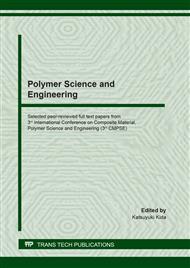p.3
p.14
p.20
p.27
p.33
p.41
p.47
p.53
p.59
Alleviation of Stress Concentration with Rivet-Like Joints Fabricated by Friction-Stir Forming
Abstract:
In this paper, the authors propose a design for the mechanical joining of dissimilar materials by employing rivet-like structures fabricated by friction-stir forming (FSF) considering the stress concentration on the joined material. The authors have utilized the FSF approach to generate rivet-like joints as follows. First, a substrate material (an aluminum alloy plate) was placed on a joined dissimilar-material plate containing prepared holes, i.e., a steel plate. Afterwards, these materials were placed on a die containing the cavity to fabricate the head of the rivet-like structure. FSF was then conducted to form the stems and heads of the rivet-like structure from the substrate material. Unlike conventional riveting, fastener was not considered necessary for the process; therefore, choosing different diameters of the prepared holes with multiple joints for the optimization of their structural design was easier. It is known that two auxiliary holes neighboring a main hole on either side reduce the stress concentration on the rim of the main hole. In this study, the authors applied the “round-hole-array design” on rivet-like joints fabricated by FSF. The authors examined the design of two smaller prepared holes with a commercial Finite element analysis (FEA) software for the rivet-like joint containing a 4 mm-diameter hole on a joined plate. To prove this, a 3 mm-thick A5083P-O aluminum alloy plate and a 0.7 mm-thick and 20 mm-wide SPCE steel plate was joined with the suggested design, and the strength and fracture of the joints were investigated using the tensile shear test. As a result, all joints were destroyed by the facture of the prepared holes, and it was confirmed that their strength was improved by the round-hole-array design.
Info:
Periodical:
Pages:
33-38
Citation:
Online since:
August 2020
Price:
Сopyright:
© 2020 Trans Tech Publications Ltd. All Rights Reserved
Share:
Citation:


